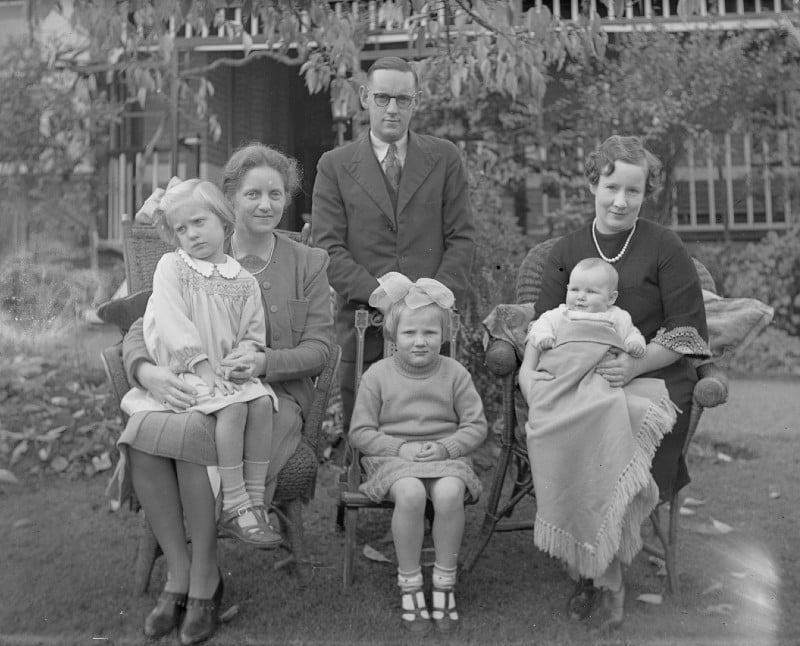Nineteenth century family history resources are plentiful, but it can be a challenge to find information on people who lived in the twentieth and twenty-first centuries.
While older records can be found in state births, deaths and marriages registers, and newspapers on the Trove website, privacy laws do not allow access to more recent birth, death and marriage registers. 1 Newspapers are a great source of information about people, but you need the name and date of the newspaper if you wish to avoid trawling through years of issues.

Here’s where the Ryerson Index can be a wonderful help to family history researchers. It’s a research tool for finding information about deceased family members and friends: a free online index of Australian newspaper death and funeral notices, right up to date.
Compiled by family history volunteers, it originally comprised notices from New South Wales newspapers only (it indexes over two million notices from the Sydney Morning Herald alone), but the Ryerson Index now also indexes notices from several Victorian and interstate newspapers. Once you have the index information, you have the title and date of the newspaper containing the death notice.

The index was named after Joyce Ryerson, who was a member of the Sydney Dead Persons’ Society. Her fourteen-year collection of death notices from the Sydney Morning Herald provided the initial material for the index. 2
The great thing about Ryerson is that it is easy to search:
- On the homepage, click on the Search Ryerson button.
- In the search boxes, type in the surname and the first name of the deceased person and click search.
This gives you a list of notices of people of that name. Even if a person has a common name, it’s not usually difficult to find the right person.
Ryerson lists the name, date of death or funeral, age of the deceased, place of death, title of the newspaper holding the death notice and the date of publication. Usually it includes the middle name of the person.

Ryerson does not include the full death notice, but it provides the vital information to find it: the title of the newspaper and the date of the death notice.
Once you have this information, you can look up the newspaper on microfilm in our Newspapers & Family History Reading Rooms or find the online newspaper (We have The Age and Sydney Morning Herald, as published, online from 2006 onward- see our A-Z databases) .
State Library Victoria holds archives of Victorian newspapers on microfilm in our Newspapers & Family History Reading Rooms. Interstate newspapers and some older country Victorian newspapers need to be requested from storage.
The newspapers give you the full death notices with the name of the deceased person, the name of the spouse and usually, the names of adult children and grandchildren. If you have been out of touch with the family, it is useful for finding the names of the spouses or partners of the adult children and the grandchildren.
The notices have clues to the family’s history: if no name is listed after the name of an adult child, this could indicate that they never married or do not have a partner. It is not foolproof, but it helps to build up a picture of the family members’ lives.

Death notices often have heart-felt tributes from family members and others who knew them, providing an insight into the deceased person’s character and relationships. Other information may be extracted from the death notice, for example, the married name of a woman or her maiden name, which lets you verify that you have the right person.
If another family member has pre-deceased the deceased, the abbreviation (dec.) appears after their name. This is a vital piece of family information. You can search again for a notice for the other deceased relative to find out more.
A few searches of the index often enables you to make a number of connections in the history of a family.
Ryerson includes funeral notices and the NSW Probate Index 2019-2022.
The Mytributes website also has death notices from different newspapers from across Australia.
State Library Victoria has research guides on many topics, including Researching your Victorian ancestors and Finding items in newspapers.
- Victorian birth registers can be searched on the Victorian births, deaths and marriages website 100 years after the event; marriages 60 years after the event and deaths, 30 years after the event.
- For biographical information see Joyce Ryerson: founder of the Ryerson Index



For many years I have been a small contributor to the Ryerson Index indexing my local country town paper, along with a bit of indexing of other papers, and a short stint on the committee, so it is great to get feed back like this as to how the Ryerson Index has helped research.
Thank you Barbara
I’m hoping to get started with the family tree of my husband. This information will be very useful.
Many thanks
Helen
Thank you so much for this reminder about the Ryerson and how use it. Much appreciated.
I am looking for the names of two people I went to school with.
Their names are Elizabeth Moore and Christine Graham. Their surnames may have changed if they had got married.
They may well be still alive. My old school has no record of their whereabouts.
Karen, if you think they may be deceased, you can try the Ryerson Index under their maiden names, as sometimes the maiden name is listed. (It may also refer to the married name). You could also search under the name of a deceased parent, as it may mention the names of the adult children and the married names of the daughters. I found the married name of an old friend that way. It can be hard to find information on living people who are neither famous nor notorious!
You can try a Google search using the first and last names in inverted commas, for example., “Elizabeth Moore”, trying the maiden name and the married name, whichever you have. Add the name of the place where they lived, or their occupation, to try to narrow it down. You may also add Australia to exclude the large number of American names. Sometimes family reunions are found on the Internet, so you could also try the names of other family members.
Newspapers can be a source of information, but you need to know the name of the newspaper and a likely date range, then you can come into the State Library and go through old issues of newspapers. Some newspapers are online with the State Library, for example The Age and The Sydney Morning Herald. A librarian can check what newspapers are held for a specific location if you phone us on 8664 7002 or complete the online form at https://www.slv.vic.gov.au/interact-us/ask-librarian.
If there is a Canberra connection, the Trove website has the Canberra Times from 1926 to 1995. https://trove.nla.gov.au/search/advanced/category/newspapers
Best of luck with your research!
I’m so happy I’ve found this. I subscribed to the Victorian Library for work (I live in Brisbane and work in the transport department) so this was a happy accident. I’ll be using this information for many years to come. Thank you Barbara
If the index is as detailed as said, it will be a wonderful help for searchers
A timely reminder again! I’ll get right on to it. Thanks.
I have found the Ryerson’s Index invaluable. Sometimes it is the only record I can find on a family member. I appreciate the volunteers painstakingly work, if not for them some valuable information would be lost in the mists. Thank you.